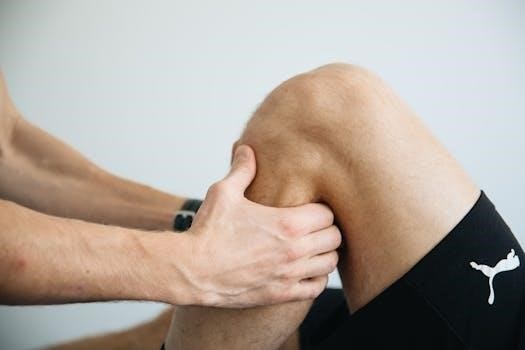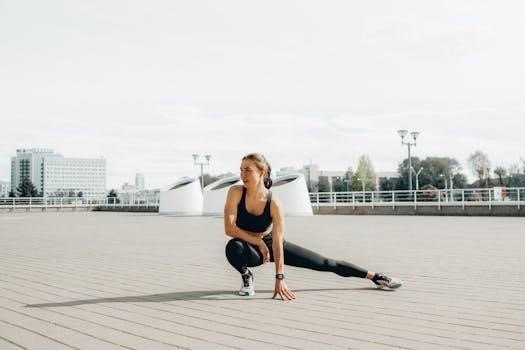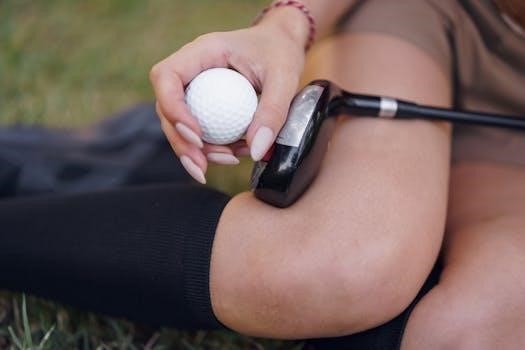Total Knee Replacement Exercises⁚ A Comprehensive Guide

Total Knee Replacement Exercises⁚ A Comprehensive Guide
Welcome to a comprehensive guide on total knee replacement
exercises! This resource is designed to provide you with valuable
information and guidance on exercises after total knee arthroplasty․
Regular exercise is crucial for regaining knee mobility, strength, and
a return to everyday activities following surgery․
Total knee arthroplasty (TKA), commonly known as total knee replacement,
is an elective surgical procedure aimed at treating arthritic knees․ The
procedure involves replacing the damaged knee joint with an artificial knee
implant, typically consisting of metal and plastic components․ Following TKA,
a structured rehabilitation program is essential for a successful recovery․
Rehabilitation after TKA focuses on several key areas, including pain
management, regaining range of motion, strengthening the surrounding
muscles, and improving functional abilities․ The rehabilitation process is
typically divided into stages, with each stage focusing on specific goals
and exercises․ Early post-operative exercises aim to control pain and
inflammation while gently restoring knee motion․ As healing progresses, the
focus shifts to strengthening exercises to rebuild muscle strength and
stability․

A well-designed rehabilitation program, guided by physical therapists, plays a
vital role in achieving optimal outcomes after TKA․ The exercises outlined
in this guide are intended to provide a general framework, but individual
progress and specific consultant requirements should always be considered․
Remember to perform all exercises within your tolerance level and closely
monitor your incision for any signs of strain․
Goals of Post-Operative Rehabilitation
Goals of Post-Operative Rehabilitation
The primary goals of post-operative rehabilitation following a total knee
arthroplasty (TKA) are multifaceted and crucial for a successful recovery․
First and foremost, controlling joint pain, swelling, and hemarthrosis is
paramount․ Minimizing these factors allows for more effective participation
in the rehabilitation program and promotes faster healing․
Regaining normal knee flexion and extension is another key objective․
Restoring a functional range of motion is essential for performing everyday
activities such as walking, climbing stairs, and sitting comfortably․
Furthermore, strengthening the muscles surrounding the knee joint,
particularly the quadriceps, hamstrings, and calf muscles, is vital for
stability and support․
Improving balance and proprioception, the body’s ability to sense its
position in space, is also an important aspect of rehabilitation․ This helps
to prevent falls and ensures safe ambulation․ Finally, the ultimate goal of
post-operative rehabilitation is to maximize functional potential, enabling
patients to return to their desired activities and improve their overall
quality of life․ The rehabilitation program should be tailored to each
individual’s needs and progress, with careful monitoring and adjustments as
necessary․
Stage I Rehabilitation⁚ Early Post-Operative Exercises (0-2 Weeks)
Stage I Rehabilitation⁚ Early Post-Operative Exercises (0-2 Weeks)
Stage I rehabilitation, spanning the first 0-2 weeks post-surgery, focuses on
reducing pain and inflammation while gently restoring range of motion․
Prioritize exercises to regain extension while minimizing strain on the
incision․ Gentle strengthening exercises are introduced, primarily aimed at
activating the quadriceps muscle․ Continue with RICE (Rest, Ice, Compression,
and Elevation) protocol․
Exercises performed during this stage typically include ankle pumps to
promote circulation, passive knee extension stretches to achieve full
extension, and active-assisted range of motion exercises for knee flexion․
Quad sets, which involve tightening the thigh muscles, and straight leg
raises are also initiated to begin strengthening the quadriceps․ Hip
abduction and adduction exercises help to maintain hip mobility and
strength․
Cryotherapy, or ice application, plays a crucial role in managing pain and
swelling․ Throughout Stage I, it’s essential to adhere to any specific
guidelines provided by your consultant and to progress exercises based on
your symptoms and functional ability․ Monitor for any signs of excessive
strain on the incision and adjust activity accordingly․
Ankle Pumps and Leg Elevation
Ankle Pumps and Leg Elevation
Ankle pumps are a fundamental exercise in the early stages of total knee
replacement rehabilitation, primarily aimed at improving circulation and
preventing blood clots in the lower legs․ To perform ankle pumps, gently
point your toes up towards your nose and then down towards the surface,
repeating this motion rhythmically․ You can perform these exercises with
both ankles simultaneously or alternate between feet․
Coaches often recommend performing ankle pumps frequently throughout the day,
such as 10 repetitions per hour while awake․ Leg elevation is another
crucial component of early post-operative care․ Elevating your leg helps to
reduce swelling and promote fluid drainage from the surgical area․ To
elevate your leg, support it on pillows or a cushion, ensuring that your
knee is slightly higher than your heart․
Combining ankle pumps with leg elevation can further enhance circulation and
reduce swelling․ These simple yet effective exercises are typically
performed in bed or while sitting in a comfortable chair․ Remember to
maintain a comfortable position and avoid any excessive strain on the
surgical site․ Consistent performance of ankle pumps and leg elevation
contributes significantly to a smoother and more comfortable recovery
process․
Passive Knee Extension and Flexion Exercises
Passive Knee Extension and Flexion Exercises
Passive knee extension and flexion exercises are vital components of early
rehabilitation following total knee replacement․ These exercises focus on
gently restoring range of motion in the knee joint without engaging your own
muscles․ For passive knee extension, lie on your back with your leg
supported, and allow gravity to gently straighten your knee․
You can also use a towel or rolled-up blanket under your ankle to encourage
full extension․ The emphasis should be on achieving complete knee extension,
aiming to eliminate any bend in the knee․ Passive knee flexion involves
using external assistance, such as your other leg or a therapist, to bend
your knee․
While sitting or lying down, gently slide your heel towards your buttocks,
bending your knee as far as comfortable․ It’s crucial to perform these
exercises slowly and deliberately, avoiding any forced movements or pain․
Passive exercises help to prevent stiffness and promote healing by gently
mobilizing the knee joint․ Remember to adhere to your physical therapist’s
guidelines and gradually increase the range of motion as tolerated․
Quad Sets and Straight Leg Raises
Quad Sets and Straight Leg Raises
Quad sets and straight leg raises are fundamental exercises for activating
and strengthening the quadriceps muscles after total knee replacement․ Quad
sets involve contracting the quadriceps muscles on the front of your thigh
while keeping your leg straight․ To perform a quad set, lie on your back
with your leg extended and tighten your thigh muscles, pressing the back of
your knee down into the surface․
Hold the contraction for 5-10 seconds, then relax․ Repeat this exercise
several times throughout the day․ Straight leg raises build upon quad sets by
adding a lifting component․ While lying on your back with your leg straight,
tighten your quadriceps muscles as in the quad set, and then slowly lift
your entire leg a few inches off the ground․
Keep your knee straight and your thigh muscles engaged throughout the lift․
Hold the leg in the raised position for a few seconds, then slowly lower it
back down․ These exercises are crucial for regaining control and strength in
the quadriceps, which are essential for walking, standing, and other daily
activities․ Perform these exercises as instructed by your physical
therapist, paying close attention to proper form and technique․
Abduction and Adduction Exercises
Abduction and Adduction Exercises
Abduction and adduction exercises are designed to improve hip strength and
stability following total knee replacement․ These exercises target the
muscles on the outer and inner thighs, which play a crucial role in
supporting the knee joint and controlling leg movement․ Abduction involves
moving your leg away from the midline of your body, while adduction involves
moving your leg back towards the midline․
To perform abduction exercises, lie on your back or side with your legs
straight․ Slowly slide your leg out to the side, keeping your kneecap and
toes pointing towards the ceiling․ Focus on using the muscles on the outside
of your hip and thigh to control the movement․ Avoid twisting your body or
lifting your leg too high․
For adduction exercises, lie on your back with your legs straight or on your
side with the operated leg on top․ Slowly slide your leg inwards towards the
midline of your body, crossing it slightly over your other leg if possible․
Engage the muscles on the inside of your thigh to perform the movement․
These exercises help improve hip strength, which is essential for stability
and balance during walking and other functional activities․
Stage II Rehabilitation⁚ Strengthening Exercises

Stage II Rehabilitation⁚ Strengthening Exercises
Stage II rehabilitation focuses on progressively strengthening the muscles
around the knee joint to enhance stability, support, and overall function․
This stage typically begins around 2-3 weeks post-surgery, depending on
individual progress and surgeon recommendations․ The goal is to gradually
increase the intensity and resistance of exercises to promote muscle
hypertrophy and improve functional capacity․ Strengthening exercises are
crucial for restoring normal gait patterns, reducing pain, and enabling a
return to daily activities․
Key exercises in Stage II include quadriceps strengthening, hamstring
strengthening, and calf raises․ Quadriceps strengthening exercises, such as
leg extensions and wall squats, target the muscles on the front of the thigh,
which are essential for knee extension and stability․ Hamstring strengthening
exercises, such as hamstring curls, target the muscles on the back of the
thigh, which are important for knee flexion and controlling deceleration․
Calf raises help strengthen the muscles in the lower leg, which contribute
to ankle stability and push-off during walking․ It is important to perform
these exercises with proper form and gradually increase the resistance or
repetitions as tolerated․ Monitor for any signs of pain or swelling and
adjust the exercise program accordingly․
Knee Extension Exercise (90-0 Degrees)
Knee Extension Exercise (90-0 Degrees)
The knee extension exercise, focusing on the range of motion from 90 degrees
to full extension (0 degrees), is a crucial component of post-operative
rehabilitation following a total knee replacement․ This exercise aims to
restore the ability to fully straighten the leg, which is essential for
normal walking, balance, and functional activities․ Achieving full knee
extension helps prevent stiffness, reduces pain, and optimizes the biomechanics
of the lower limb․
To perform this exercise, sit in a chair with your feet flat on the floor․
Gradually extend your knee, aiming to straighten your leg as much as
possible․ Hold the fully extended position for a few seconds, focusing on
engaging the quadriceps muscles․ Slowly return to the starting position․
It is important to perform this exercise with controlled movements and avoid
any jerky motions․
If you experience difficulty achieving full extension, you can use a towel
or rolled-up blanket under your ankle to encourage a greater range of motion․
Alternatively, you can perform the exercise while lying down, allowing
gravity to assist with the extension․ Consistency and gradual progression
are key to successfully restoring full knee extension․
Gait Training and Ambulation
Gait Training and Ambulation
Gait training and ambulation are fundamental aspects of rehabilitation
following total knee replacement, focusing on restoring a safe and efficient
walking pattern․ The goal is to regain the ability to walk with proper
mechanics, balance, and confidence․ This involves gradually increasing
walking distance and speed while addressing any gait deviations that may
have developed due to pain or stiffness before surgery․
Initially, gait training may involve using assistive devices such as walkers
or crutches to provide support and stability․ As strength and balance
improve, the reliance on these devices can be gradually reduced․ The focus
should be on maintaining an upright posture, taking even steps, and avoiding
limping․ It is important to pay attention to knee extension during the
stance phase of gait and ensure a smooth heel-to-toe movement․
Progression should be gradual and guided by your physical therapist․ They
will assess your gait pattern, identify any areas of weakness or
instability, and provide specific exercises and cues to improve your
walking ability․ It’s also important to practice on different surfaces and
in various environments to prepare for real-world walking situations․
Importance of Cryotherapy (Ice Application)
Importance of Cryotherapy (Ice Application)
Cryotherapy, or ice application, plays a crucial role in the post-operative
management following total knee replacement․ It is a simple yet effective
method for reducing pain, swelling, and inflammation in the knee joint․
Applying ice helps to constrict blood vessels, which in turn minimizes
tissue damage and reduces the inflammatory response․ This can significantly
contribute to a more comfortable and faster recovery․
The benefits of cryotherapy extend beyond pain relief․ By reducing swelling,
it allows for better joint mobility and range of motion, which is essential
for performing rehabilitation exercises effectively․ It also helps to
prevent the formation of excessive scar tissue, which can limit joint
movement and cause stiffness․
Ice should be applied to the knee for 15-20 minutes at a time, several
times a day, especially after exercise or activity․ It is important to
protect the skin by placing a thin towel between the ice pack and your skin
to prevent frostbite․ Consistent and proper use of cryotherapy, as directed
by your healthcare provider, can greatly enhance your recovery and
contribute to a successful outcome after total knee replacement․

Long-Term Exercise and Activity Recommendations
Long-Term Exercise and Activity Recommendations
Maintaining an active lifestyle is essential for the long-term success of
your total knee replacement․ Regular exercise helps to strengthen the
muscles around the knee, improve joint stability, and maintain range of
motion․ It also contributes to overall health and well-being, reducing the
risk of other health problems․
Low-impact activities such as walking, swimming, cycling, and water aerobics
are excellent choices for long-term exercise․ These activities put minimal
stress on the knee joint while providing cardiovascular benefits and
strengthening muscles․ It is important to gradually increase the intensity
and duration of these activities as your strength and endurance improve․
In addition to low-impact activities, incorporating strengthening exercises
into your routine is crucial․ Focus on exercises that target the quadriceps,
hamstrings, and calf muscles․ Examples include leg presses, hamstring curls,
and calf raises․ Remember to consult with your physical therapist or
healthcare provider to develop a personalized exercise plan that is safe and
effective for you․